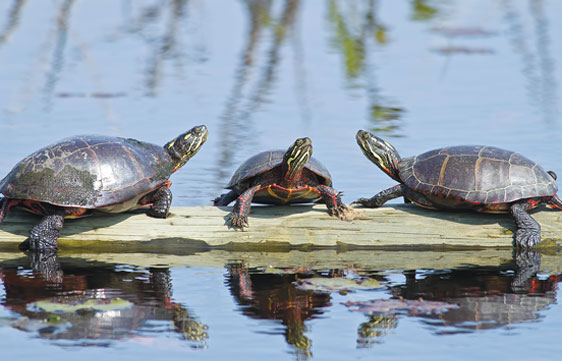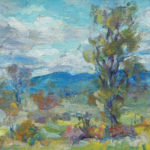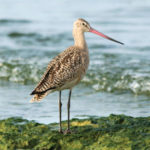
Legend has it that the turtle always beats the hare but our hard-shelled hero has some new competition and the odds aren’t in his favour.
TURTLES DESERVE OUR ATTENTION, AND NEVER MORE SO THAN AT THIS TIME OF YEAR – late May through July – when they’re actively crossing roads between their wetland habitat and their nests in sandy and gravelled sites. It’s one more good reason to drive a little slower on the byways of Watershed country, where we may encounter five turtle species, members of the 220 million year-old animal order Testudines.
Turtles have two distinct traits – long lives and low reproductive rates – that have kept them in nature’s balance for a very, very long time…that is until recently. Human activities, among them road building and the destruction of wetland habitat, are threatening their survival. In fact, seven of Ontario’s eight turtle species are on the ‘at risk’ list.
The species you are most likely to see, and the only one not at risk, is the familiar painted turtle, distinguished by its red and orange stripes and much given to sunbathing on rocks and logs. Although researchers believe numbers have declined since pre-pioneer times, the painted turtle benefits from relatively high reproductive success and an ability to adapt to polluted and disturbed wetland environments. The painted turtle is common through much of North America and found coast to coast in Canada – the subspecies you’ll see in Watershed country is the midland painted turtle. Like others of its clan, the painted turtle has a long life – a study in Michigan put some individuals at 55- years-old and counting.
If you spent your early summers wading wetlands, ponds and lake edges, you probably spotted the occasional snapping turtle – the fellow responsible for more than a few childhood phobias about stepping into murky waters. The snapping turtle, sometimes described as prehistoric in appearance, is the largest of Ontario’s turtles and can grow to nearly a half-metre long and weigh up to 16 kilograms. The snapping turtle’s fearsome reputation is due to its inability to retract its head into its shell, so its only alternative is to try to bite. Truth be told, the snapping turtle’s ferocity is overstated. In the water they are much more likely to lope away along the bottom than they are to attack. Snapping turtles can live a long, long time – up to 100 years, but their reproductive rates are low. The survival of each individual adult is extremely important. They are on the ‘at risk’ list as a species of special concern, so if you see one trying to cross a road, give it an assist in the direction it appears to be going. It’s not a bad idea to keep a snow shovel in the trunk specifically for these kinds of encounters.
Prince Edward County’s ample wetlands and shorelines make it a hotspot for Ontario turtle diversity, and some turtle-related controversy as well. At the centre of one recent environmental storm was the Blanding’s turtle, a medium-sized species easily recognized by its yellow chin and domed shell. In 2013, a proposal to build nine wind turbines on a 324-hectare patch of Crown land at Ostrander’s Point, on the County’s south shore, was defeated when naturalists argued the project would fragment Blanding’s turtle habitat. The Blanding’s turtle, found primarily in the Great Lakes region with isolated east coast populations, is on the endangered list due to the usual suspects – habitat loss, road kill, and slow rates of reproduction. Left on its own, unmolested by human intrusion, the Blanding’s turtle can live eight decades or more and, over that time, shows little impact from aging, making it of interest to researchers trying to extend human lifetimes.
The wetland shorelines of Prince Edward County, as well as in the nearby Presqu’ile area, are good places to watch for the Northern map turtle, listed as a species of special concern. The map turtle gets its name from the yellow, tan and orange lines of its shell, which are said to resemble the contour lines on a map. Getting close enough to see those lines may be a challenge. The map turtle is a wary creature which will quickly jump into the water from its communal basking spots when it senses danger. Map turtle populations suffer from the usual threats of cars and habitat destruction, and are susceptible to declines in water quality that impact the molluscs the female turtles eat. The map turtles’ habit of basking underneath mats of floating vegetation also puts them at risk to boat propellers.
Population maps show the County as a stronghold for the Eastern musk turtle, which you may know by the unfortunate but descriptive name ‘stinkpot.’ The stinkpot is a tiny turtle, typically about 13 centimetres long, named for the skunk-like odour it produces when disturbed. Consider yourself warned. The Eastern musk, too, is a species of special concern vulnerable to drought, habitat destruction, changes in water levels that can drown eggs, heavy motorboat traffic, and intense fishing.
We should make mention of Ontario’s other three turtle species, although you’d be very unlikely to see them in Watershed country. The Ontario Natural Heritage Information centre shows two small sites in Presqu’ile and Prince Edward County as locations for the endangered spiny softshell turtle, a highly aquatic species easily recognized by its round, leathery shell and snorkel-like snout. But most of the remaining spiny softshells are in southwestern Ontario.
The spotted turtle, also endangered, is a tiny member of the clan, measuring less than 13 centimetres long. Its population in Ontario has plummeted to only 2,000 individuals.
And finally there’s the endangered wood turtle, found in just three sites in Ontario. These isolated populations are being studied to determine their size and threats to their survival.
INJURED TURTLES
It’s essential for turtle species’ survival that each adult lives a long and reproductive life. So if you encounter an injured turtle you should note details of the animal’s location, carefully place it in a lidded and ventilated plastic container, and call the Ontario Turtle Conservation Centre at (705) 741-5000.
Located in Peterborough, the centre operates a hospital that treats, rehabilitates and releases injured turtles, working in partnership with 30 turtle first response centres across the province, including some veterinary clinics in Watershed country. Depending on circumstances you might drive the injured turtle to Peterborough or take it to a partner clinic for treatment and further transportation. “The goal is to get a turtle to the trauma centre,” says Marlena MacKenzie, a veterinary technician at the Bay Regional Veterinary Hospital in Belleville.
She explains that while the staff at Belleville’s Bay Regional hospital are trained to stabilize and provide pain medication to injured turtles, any further specialized treatment is only available in Peterborough. “If a turtle is badly injured, our objective is to get the turtle to Peterborough.”
Story by:
Norm Wagenaar




